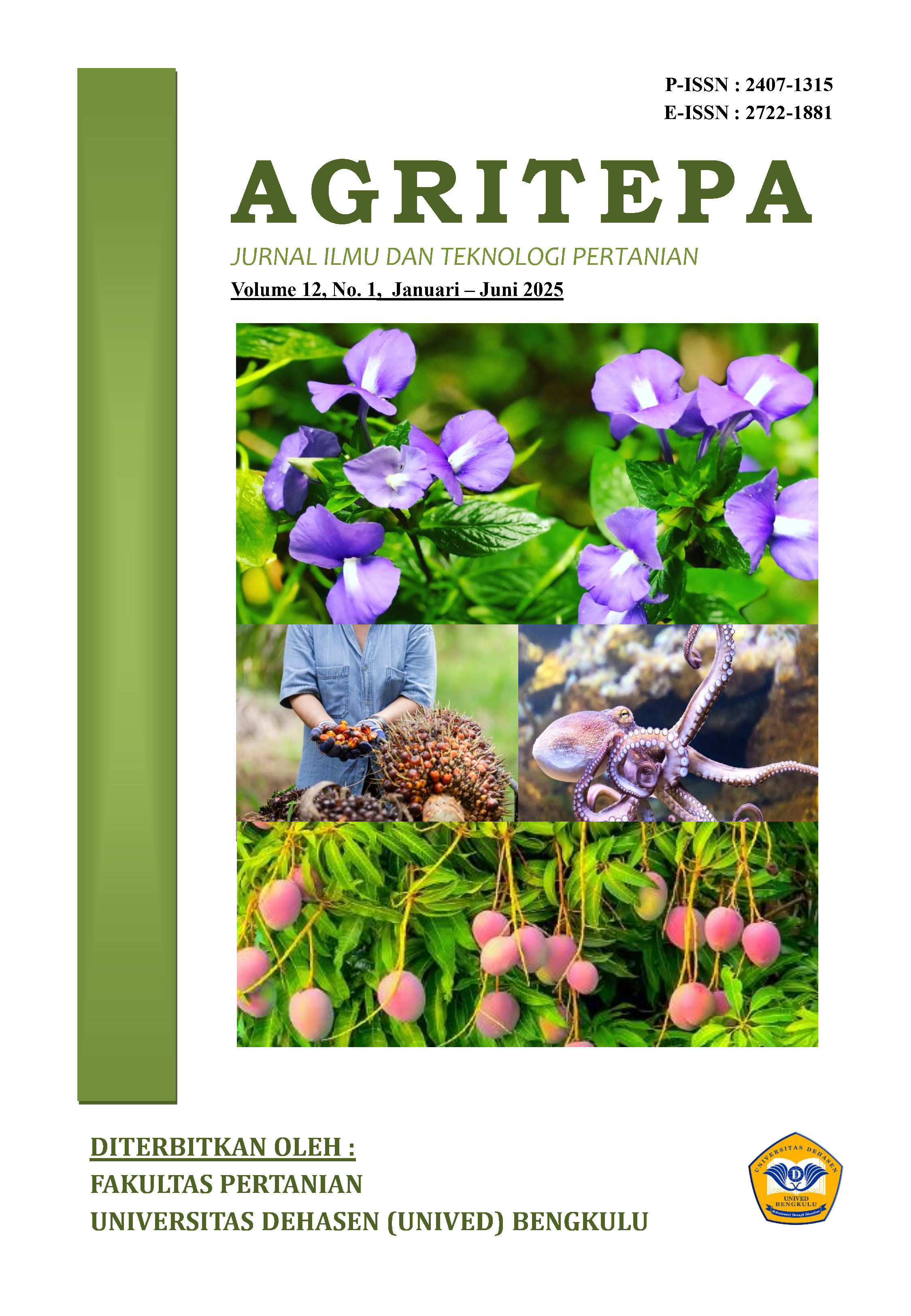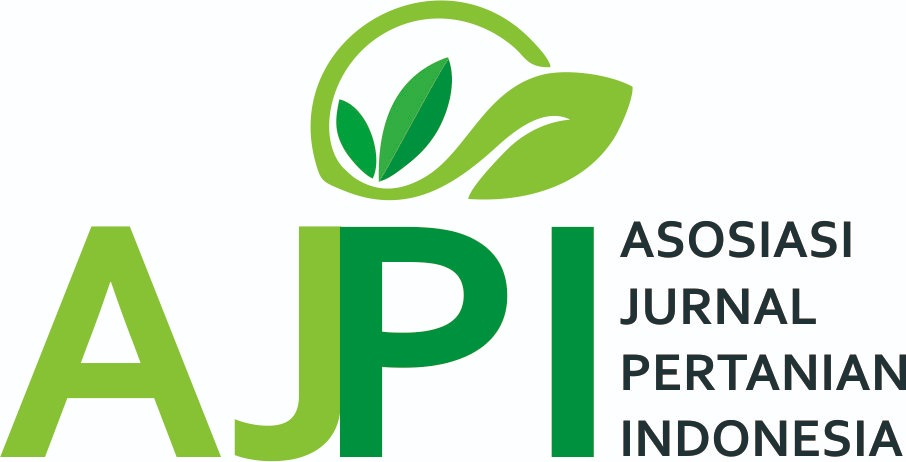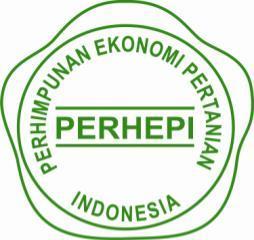Optimization Approach of Microwave Assisted Extraction Anthocyanins Pigments Butterfly Pea Flowoers (Clitoria Ternatea L.) Using OFAT (One-Factor-At-a-Time) Method
Abstract
Optimization of anthocyanin pigment extraction from butterfly pea flowers (Clitoria ternatea L.) is an important focus to increase the efficiency of obtaining valuable active compounds. This study marks an initial approach in the application of Microwave-Assisted Extraction (MAE) using 0.75% aquadest-tartaric acid solvent, with the hope of producing more stable anthocyanins. The main objectives of this study were to identify the effect of the solvent-material ratio, extraction duration, and MAE power level on anthocyanin levels (mg/L) through the One-Factor-At-a-Time (OFAT) method. The results showed that the optimal treatment was obtained at condition P17, with a solvent-material ratio of 1:15, an extraction time of 15 minutes, and an MAE power of 450 watts, which produced an anthocyanin level of 33.89 ± 0.47 mg/L. These findings confirm that increasing the solvent-material ratio to the optimal point contributes to increasing anthocyanin recovery. However, excessive MAE time and power can cause pigment degradation. The optimal ratio variables were found to be in the range of 1:15 to 1:25, extraction time 9–15 minutes, and MAE power 270–450 watts. This study is expected to be the basis for further optimization using the Response Surface Methodology (RSM) method which allows for deeper analysis of the interactions between variables.
Downloads
References
Angriani, L. (2019). Potensi ekstrak bunga telang (clitoria ternatea) sebagai pewarna alami lokal pada berbagai industri pangan:(The potential of extract butterfly pea flower (clitoria ternatea l.) as a local natural dye for various food industry). Canrea Journal: Food Technology, Nutritions, and Culinary Journal, 32-37.
AOAC. (2012). Official Methoads of Analysis of AOAC Internasional, 19 th ed, USA.
Azharini, R., Widyasanti, A., dan Nurhasanah, S. (2022). Optimasi Proses Ekstraksi Bunga Telang (Clitoria ternatea) Berbantu Gelombang Mikro Menggunakan Aplikasi Response Surface Methodology. Jurnal Teknologi dan Industri Pertanian Indonesia, 14(2), 97-102.
Belwal, T., Pandey, A., Bhatt, I. D., and Rawal, R. S. (2020). Optimized microwave assisted extraction (MAE) of alkaloids and polyphenols from Berberis roots using multiple-component analysis. Scientific reports, 10(1), 917.
Bindu, S. J., Rekha, T. and Chandran, V. (2016) Smart solar tunnel dryer, IOSR Journal of electrical and electronics engineering, 11(5):43 - 51
BPOM. (2014). Persyaratan Mutu Obat Tradisional. Badan Pengawas Obat dan Makanan (pp. 1–25).
Brady, E. A. (2014). Evaluation of phenolic compounds in sap from New Hampshire sugar maple trees by liquid chromatography/mass spectrometry (Doctoral dissertation, University of New Hampshire).
Enaru, B., Drețcanu, G., Pop, T. D., Stǎnilǎ, A., and Diaconeasa, Z. (2021). Anthocyanins: Factors affecting their stability and degradation. Antioxidants, 10(12), 1967.
Fartoosi, Z., Kolahi, M., Heidarizadeh, F., and Goldson-Barnaby, A. (2025). The impact of thermal and non-thermal processing on the phytochemical characteristics and nutritional value of Daucus carota (carrots). Applied Food Research, 100732.
Hariadi, H., Karim, M. A., Hanifah, U., Haryanto, A., Novrinaldi, Surahman, D. N., and Finni Lathifah Lubis, R. (2023). Effect of butterfly-pea powder (Clitoria ternatea L.) and drying temperature towards physicochemical characteristics of butterfly-pea milk powder with vacuum drying method. Food Science and Technology, 43, e109622.
Hartono, M. A. (2013). Pemanfaatan ekstrak bunga telang (Clitoria ternatea L.) sebagai pewarna alami es lilin. Jurnal Biologi, 1-15.
Hasdar, M. (2021). Ekstraksi Beras Hitam Sirampog Berbantu Gelombang Mikro (Microwave Assisted Extraction (Mae)). Jurnal Pengolahan Pangan, 6(2), 49-53.
Husna, A., Lubis, Y. M., dan Erika, C. (2022). Ekstraksi pewarna alami dari bunga telang (Clitoria ternatea L.) dengan variasi jenis pelarut dan lama ekstraksi. Jurnal Ilmiah Mahasiswa Pertanian, 7(2), 410-419.
Inyang, U., Oboh, I., and Etuk, B. (2017). Drying and the different techniques. International Journal of Food Nutrition and Safety, 8(1), 45-72.
Izirwan, I., Munusamy, T. D., Hamidi, N. H., & Sulaiman, S. Z. (2020). Optimization of microwave-assisted extraction of anthocyanin from Clitoria ternatea flowers. International Journal of Mechanical Engineering and Robotics Research, 9(9), 1246-1252.
Llompart, M., Garcia-Jares, C., Celeiro, M., and Dagnac, T. (2019). Extraction | Microwave-Assisted Extraction. In Encyclopedia of Analytical Science (3rd ed., Issue June). Elsevier Inc.
Migliorini, A. A., Piroski, C. S., Daniel, T. G., Cruz, T. M., Escher, G. B., Vieira do Carmo, M. A., and Rosso, N. D. (2019). Red chicory (Cichorium intybus) extract rich in anthocyanins: chemical stability, antioxidant activity, and antiproliferative activity in vitro. Journal of food science, 84(5), 990-1001.
Muttaqin, B. I. A. (2019). Telaah Kajian dan Literature Review Design of Experiment (DoE). Journal of Advances in Information and Industrial Technology, 1(1), 33-40.
Pracima, R. (2015). Pemanfaatan Ekstrak Ubi Jalar Ungu (Ipomea batatas (L.) Poir) Sebagai Zat Warna Pada Sediaan Lipstik. Skripsi. Fakultas Kedokteran Dan Ilmu Kesehatan. Jakarta: UIN Syarif Hidayatullah Jakarta.
Rafi, M., Febriany, S., Wulandari, P., Suparto, I. H., Ridwan, T., Rahayu, and S., Siswoyo, D. M., (2018). Total Phenolics, Flavonoids, and Anthocyanin Contents of Six Vireya Rhododendron from Indonesia and Evaluation of their Antioxidant Activities. Journal of Applied Pharmaceutical Science, 8(9): 49-54.
Rifqi, M. (2021). Ekstraksi antosianin pada bunga telang (Clitoria ternatea L.): Sebuah ulasan. Pasundan Food Technology Journal, 8(2), 45-50.
Salve, R. R., and Ray, S. (2020). Comprehensive study of different extraction methods of extracting bioactive compounds from pineapple waste—A review. The Pharma Innovation Journal, 9(6), 327-340.
Sukmawati, N., Simanjuntak, B. Y., and Wahyudi, A. (2024). Analysis Of Water Content, Fiber, Anthocianin and Organoleptic Acceptance of Butterfly Pea Jelly Powder (Gatela) At Various Drying Temperatures of
Seaweed. National Nutrition Journal/Media Gizi Indonesia, 19(1).
Thuy, N. M., Ben, T. C., Minh, V. Q., and Van Tai, N. (2021). Effect of extraction techniques on anthocyanin from butterfly pea flowers (Clitoria ternatea L.) cultivated in Vietnam. J Appl Biol Biotechnol, 9(6), 173-80.
Widhianto, N., dan Estiasih, T. (2021). Kajian Literatur: Ekstraksi Antosianin dengan Berbagai Teknologi Ramah Lingkungan Mutakhir (Emerging Green Technology) dan Efikasi Khasiat Antosianin sebagai Antiinflamasi dan Antikolesterol (Doctoral dissertation, Universitas Brawijaya).
Yarkwa, B. and Uvir, R. H. (2015) Effects of Drying Methods on the Nutritional Composition of Unripe Plantain Flour, Food Science and Quality Management, 41: 1 - 7
Copyright (c) 2025 Muhammad Daffa' Aththobarani, Anugerah Dany Priyanto (Author)

This work is licensed under a Creative Commons Attribution-ShareAlike 4.0 International License.
Author retains the copyright and grants the journal the right of first publication of the work simultaneously licensed under the Creative Commons Attribution-ShareAlike 4.0 License that allows others to share the work with an acknowledgement of the work's authorship and initial publication in this journal













